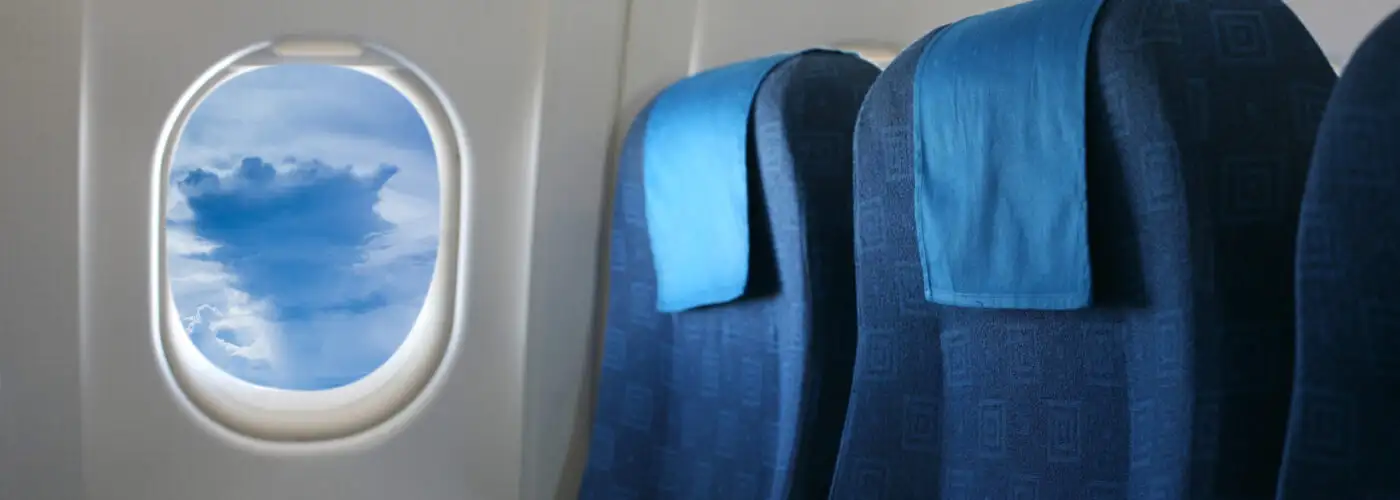As airlines continue to cram more and more people into each plane, the flying experience gets less comfortable for all passengers, especially passengers of a heavier weight. But is there a point where seat sizes restrict someone’s ability to fly? Most carriers now have some sort of policy in place to ensure that all passengers have adequate room for both comfort and safety, but policies differ in degree and detail.
Most airlines recommend that if you think you will be too large for your seat, you should purchase a second seat at the time you make your original booking (or, of course, buy a ticket in first or business class). Some airlines will offer a discount on the second seat or refund the cost if the plane isn’t full, but in many cases larger passengers simply have to pay twice the price as other flyers.
Are Airline Passenger Weight Policies Fair?
Airline seating policies surrounding passenger weight bring up some sensitive issues. Who decides if someone fits in the seat, and when do they decide? Is the decision left up to a flight attendant after the entire plane has boarded? Is it somebody at the gate? At check-in? Will there someday be a BMI (Body Mass Index) field on booking sites? Might we eventually have to sit in a test seat, much like the metal cages that measure the size of your carry-on bag?
Over the years, some of these questions have moved out of the realm of the rhetorical—though there have been very few cases where the airlines’ policies have been tested or disputed in public (not surprisingly, due to the very sensitive nature of the issue). Most overweight travelers have simply taken the abuse, or made their case without going too public.
On a broader level, is it fair or logical for the airlines to keep shrinking airplane seats while requiring those left behind to, oftentimes literally, pay the price? This makes things awkward for everyone—including the large passengers themselves. (See the moving essay What it’s like to be that fat person sitting next to you on the plane.)
There is a simple solution, of course: wider seats on planes. In the same way that airlines offer “economy plus” sections with more legroom, they could have rows that have fewer and wider seats. (There’s always the option of business class in this case, but airlines could do the same thing in economy class, just without the free booze, dedicated loo, and big upcharges.)
The airlines argue it would be too costly to retrofit planes to include larger seats—so for now, the traveling public is stuck with the status quo. Below is a run-down of seating policies regarding passenger weight on several major airlines in the U.S. and abroad.
Alaska Airlines’ Customers of Size Policy
Alaska Airlines requires the purchase of a second seat for any passenger who can’t “comfortably fit within one seat with the armrests in the down position.” If you purchase a second seat in advance, and your flights all take off with at least one seat available, you can get a refund for the cost of the second seat. For those who haven’t purchased a second seat in advance, you may do so the day of your flight; if two seats aren’t available together, you might need to take a later flight.
Allegiant’s Passenger of Size Policy
Allegiant recommends that passengers who are unable to lower their armrest purchase a second ticket at the time of booking. If the passenger waits until the day of travel to request a second seat, “the agent will be unable to sell a second ticket unless two seats are available side-by-side,” says the airline website. If an extra seat is unavailable, the passenger will not be able to fly.
American Airlines’ Extra Space Policy
American requires passengers to purchase a second seat if they need a seatbelt extension and “extra space outside a single seat to travel safely.” The airline recommends that you buy both seats during your original booking (at the same rate). If you don’t book two seats in advance, you will be responsible for any fare difference on a second seat purchased the day of your flight or a larger seat in a higher class. If the airline can’t accommodate you on your scheduled flight, the airline will let you purchase two seats on a later flight for the same price as your original seats.
Delta Airlines’ Extra Seat Space Policy
Delta does not require larger passengers to purchase an extra seat, even if a seatbelt extender is required. However, the website notes that “if a passenger impedes on another passenger, they may be asked to move to another location that provides additional space, or in the event of a full flight, be asked to take a later flight with available seating.” and therefore recommends passengers who require extra space to purchase a second seat at the time of booking.
Frontier’s Customer of Size Policy
Frontier requires that customers who are unable to lower both armrests purchase a second seat “prior to travel.”
Hawaiian Airlines’ Policy for Guests Needing Additional Room
Hawaiian recommends that flyers who can’t sit comfortably with both armrests lowered call in advance to reserve a second seat. If you don’t do this, the airline “will try to find a suitable alternative,” but if this isn’t possible, you may not be able to fly on your originally scheduled flight.
JetBlue’s Extra Seating Policy
I was unable to find an official policy on JetBlue’s website, however JetBlue has a process in place for booking a second seat for any reason, found here. JetBlue seats are between 17.8 and 18.4 inches.
Southwest Airlines’ Customer of Size Policy
Southwest encourages larger passengers to purchase an extra seat in advance to guarantee that sufficient space will be available on their flight; the airline promises to refund all extra seat purchases, even if the flight is oversold. Passengers can also wait until the day of their flight to speak with a customer service person at the gate, who will give them a complimentary additional seat if it’s available.
Spirit Airlines’ Extra Seat Policy
Spirit requires that any passenger who “encroaches on an adjacent seat area and/or is unable to sit in a single seat with the armrests lowered” purchase an additional seat. Travelers who need a seatbelt extension are not eligible to sit in a seat with an inflatable seatbelt.
United Airlines’ Extra Seating Policy
If you can’t buckle your seatbelt (with an extension if necessary) and fit into a seat with the armrests down—without encroaching “significantly” on the adjacent space—you must purchase an additional seat or pay for an upgrade to a roomier seat on United. The carrier recommends buying two seats at the time of booking, at which time you’ll pay the same fare for the second seat; if you wait until the day of travel, you’ll pay the fare available that day. If no additional seats or upgrades are available, you’ll have to rebook on the next flight with availability. (United will, however, waive the change fees.)
Airline Passenger of Size Policies Outside the U.S.
There are too many airlines around the world to enumerate every single policy, but below is a sampling.
Under the One Person One Fare program in Canada, “carriers may not charge more than one fare for persons with disabilities who…require additional seating for themselves, including those determined to be functionally disabled by obesity.” This applies to domestic service within Canada. For flights to destinations outside of Canada, you might have to purchase an additional seat.
In Europe, Air France offers a 25 percent discount on your second seat if purchased in advance, with a full refund if there are unoccupied seats on your flight. If your flight is full, you haven’t booked an additional seat, and you can’t fit comfortably into a single seat, you may not be permitted to board. Meanwhile, British Airways requires passengers to be able to fully lower both armrests; if you can’t fit into the seat under these conditions, you must purchase an extra seat.
In the Southern Hemisphere, Qantas and LATAM suggests travelers needing extra space book an extra seat. Qantas encourages passengers to book both seats at once, as an extra seat cannot be added to an existing booking and will need to be booked separately. LATAM notes that “Passengers that due to their size must out of necessity occupy the immediately adjacent seat, can only travel in Economy in order to use this service” due to the configuration of the armrests in their other cabins.
Looking for a carrier not listed above? Airline seating policies are often difficult to find on carriers’ websites. Sometimes you can pull them up by searching “extra seat” or “customer of size,” but the best strategy is to call the customer service number—if you need to purchase an extra seat, you’ll likely end up calling the airline anyway.
You Might Also Like:
• Luggage Locks: Should I Lock My Suitcase When I Fly?• 7 Air Travel Secrets You Didn’t Know
• Flying with Gifts: The TSA Rules You Need to Know
• 9 Times You’ll Regret Being Cheap When You Travel
• 7 Things You Should Never Do on a Plane
We hand-pick everything we recommend and select items through testing and reviews. Some products are sent to us free of charge with no incentive to offer a favorable review. We offer our unbiased opinions and do not accept compensation to review products. All items are in stock and prices are accurate at the time of publication. If you buy something through our links, we may earn a commission.
Related
Top Fares From
Today's Top Travel Deals
Brought to you by ShermansTravel
Greece: 9-Night Vacation, Incl. Meteora &...
Exoticca
 vacation
$2149+
vacation
$2149+
London to Reykjavik: Luxe, 10-Night Northern...
Regent Seven Seas Cruises
 cruise
$8175+
cruise
$8175+
Ohio: Daily Car Rentals from Cincinnati
85OFF.com
 Car Rental
$19+
Car Rental
$19+




